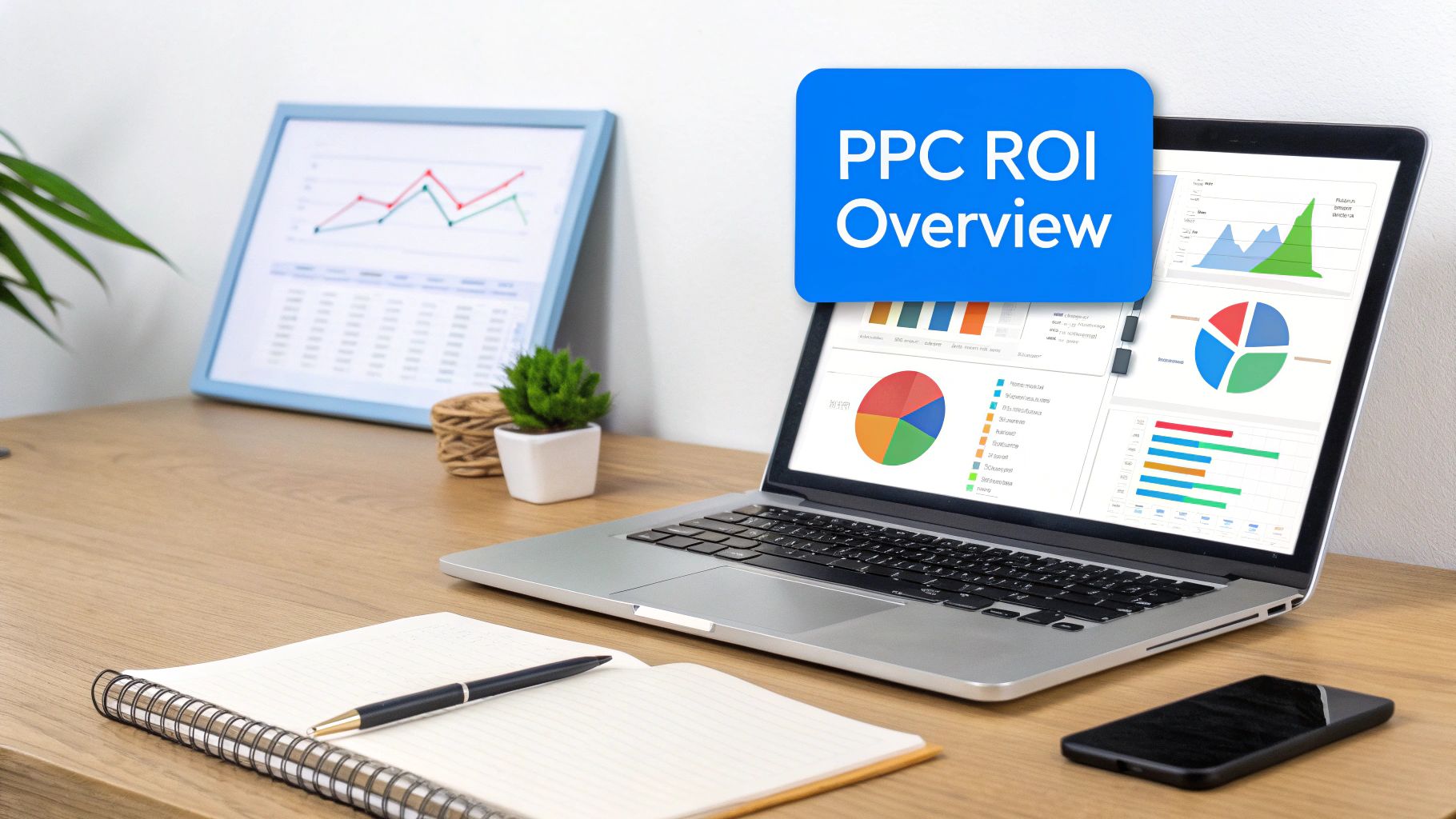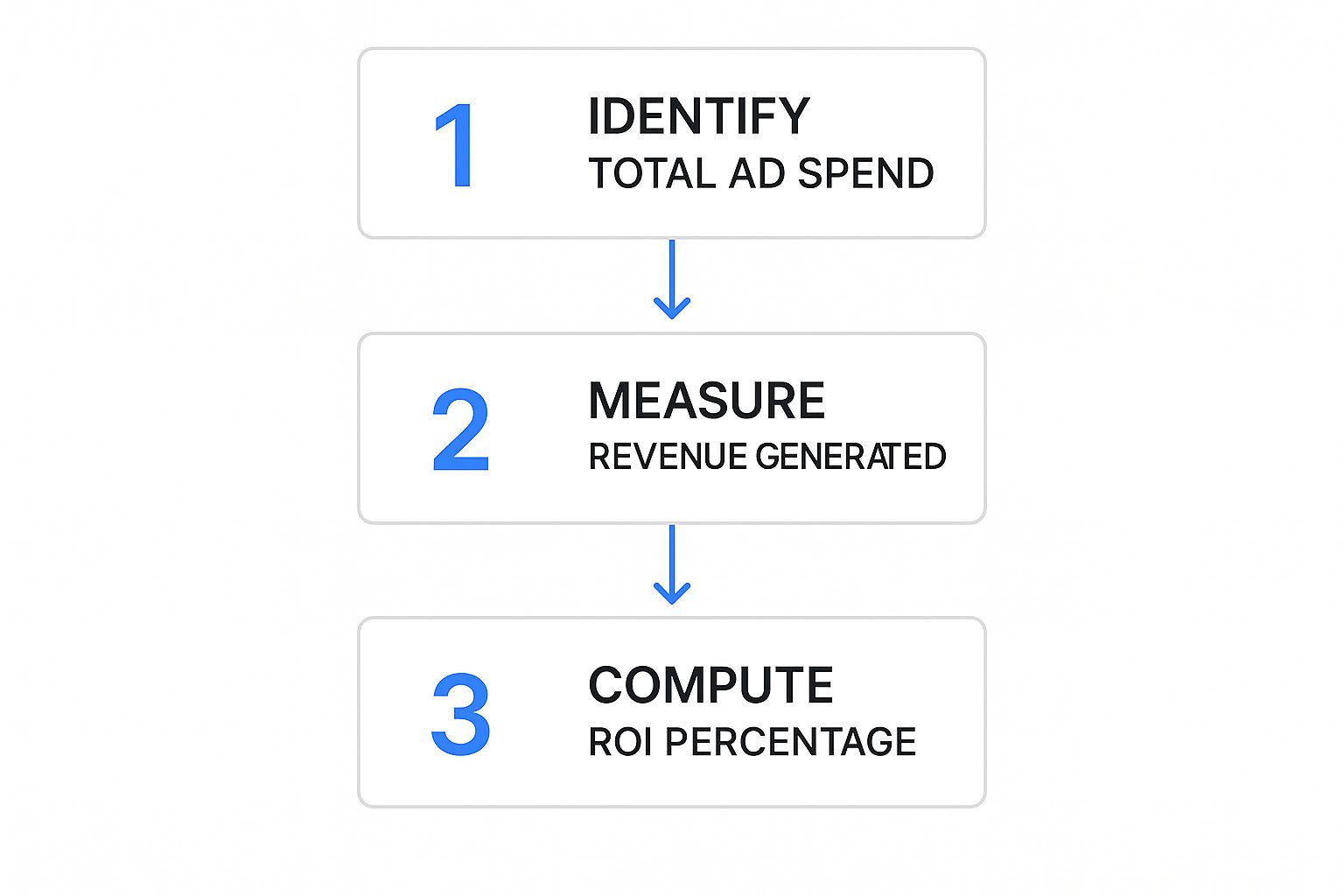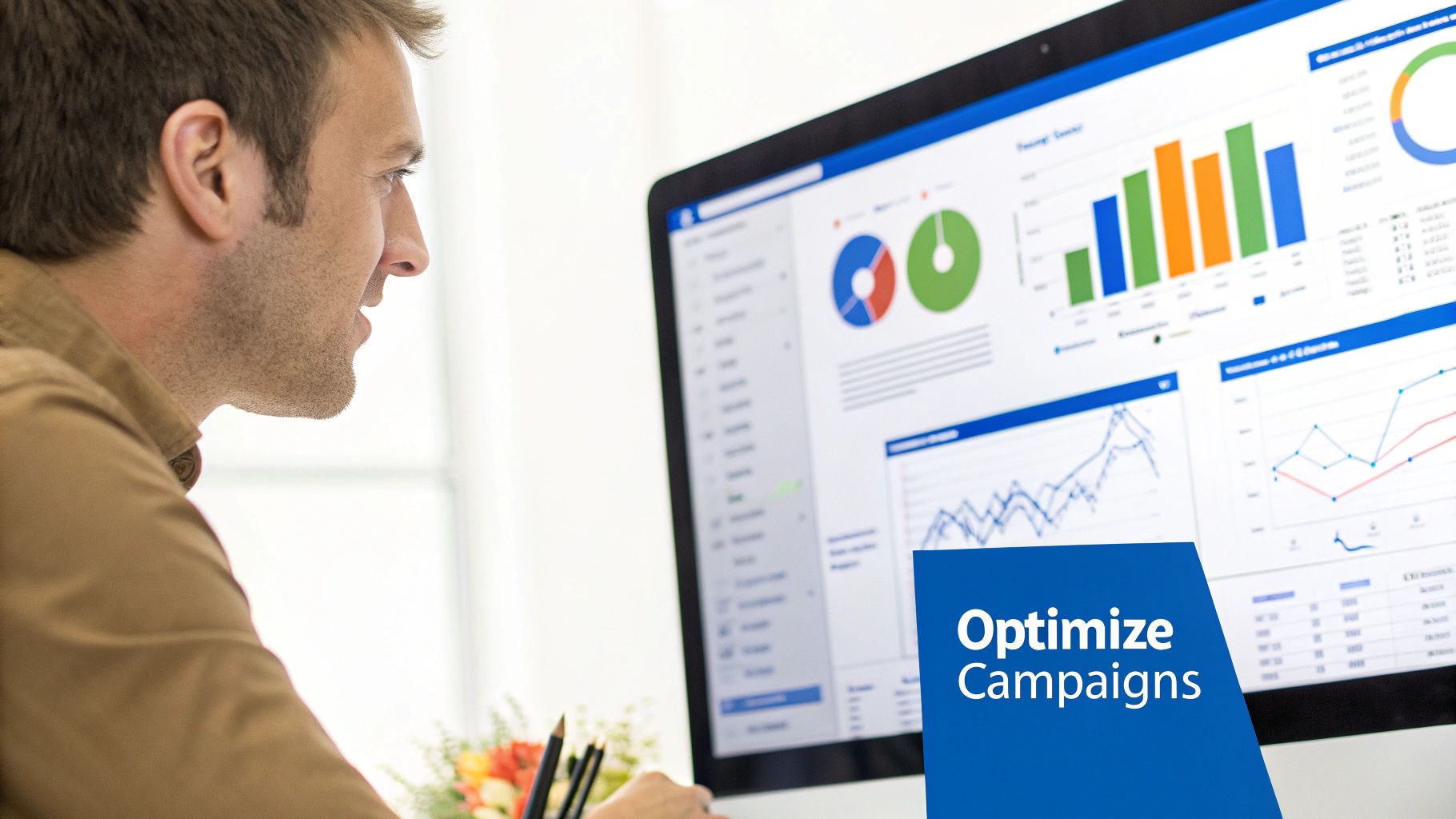A crucial part of any paid advertising strategy is knowing how to calculate your PPC ROI. At its core, this calculation reveals the actual profit generated from your campaigns relative to every single dollar you invested—not just the ad spend. Unlike simpler metrics, it provides a true measure of financial success, shifting the focus from revenue to pure profitability.

If you want to build a sustainable advertising engine, you have to move past basic metrics. While many marketers get hung up on Return on Ad Spend (ROAS), it only tells part of the story. A real, accurate PPC ROI calculation, on the other hand, is the bedrock of strategic decision-making that drives tangible profit for your business.
This isn't just about creating reports to impress stakeholders. It's about gaining the clarity you need to optimize budgets, justify your marketing spend, and scale your advertising efforts intelligently. A precise grasp of your ROI helps you answer the most critical business question: "Are my ads actually making money?"
One of the most common—and costly—mistakes in performance marketing is confusing ROI with ROAS. This isn't just a minor mix-up in terms; it's a fundamental gap in understanding that can lead to disastrous budget decisions. Believing a campaign is a huge success when it's actually losing money is a real and dangerous risk.
It's easy to get them mixed up, but their jobs are completely different.
ROAS measures the top-line revenue generated by your ads, while ROI measures the bottom-line profit you actually get to keep. Think of it this way: ROAS shows you how efficiently you're turning ad dollars into sales, but ROI tells you if those sales are actually profitable after all your other expenses are paid.
To make it even clearer, here’s a quick table breaking down the key differences between these two essential metrics.
As you can see, a high ROAS can easily hide a negative ROI if your profit margins are thin or your operational costs are high. That's why relying on ROAS alone is like trying to drive a car by only looking at the speedometer—you're moving, but you have no idea if you're headed in the right direction.
Key Takeaway: A profit-driven strategy will always beat a revenue-focused one in the long run. Focusing on ROI ensures every dollar spent contributes to your bottom line, not just top-line vanity metrics.
While industry benchmarks can be a helpful guide, achieving a solid ROI—often cited as 200-300% for strong performance—depends entirely on your unique profit margins and business costs. You can find more benchmarks and improvement timelines at MonsterInsights.
Ultimately, a meticulous approach to your PPC ROI calculation gives you the power to confidently allocate resources to winning campaigns and decisively cut those that drain your profits. It's what separates the pros from the amateurs and ensures long-term, sustainable growth for your brand.
At its core, calculating PPC ROI comes down to a simple but powerful formula. This isn't just some abstract marketing theory; it’s a hands-on calculation that keeps your ad strategy grounded in financial reality.
The formula itself is straightforward: [(Revenue - Total Costs) / Total Costs] x 100%
This gives you a clear percentage showing the net profit you’ve earned for every dollar spent. A positive number means you’re in the black. A negative one means you're losing money. Simple enough, right? But the real work—and where so many marketers get it wrong—is in how you define "Revenue" and "Total Costs."
This flowchart gives you a bird's-eye view of the process.

While the chart makes it look easy, the devil is in the details of what actually goes into those boxes.
The single biggest mistake I see when people calculate PPC ROI is that they only look at ad spend. If you want to know your true profitability, you have to account for every single expense tied to running your campaigns. If you don't, you'll end up with a dangerously inflated sense of success.
Your "Total Costs" are so much more than just what you pay Google or Meta. Think bigger.
For service-based businesses or those in niche fields, figuring out all the right inputs can get tricky. If you're in the legal sector, for example, a specialized legal marketing ROI calculator can help by accounting for industry-specific costs that you might otherwise overlook.
Let’s walk through an example to show just how dangerous incomplete data can be. Imagine an e-commerce store, “Modern Mugs,” just ran a PPC campaign for its new line of ceramic travel mugs.
Scenario 1: The Misleading, ROAS-Based View
First, they take the common—but flawed—approach of only looking at ad spend.
With these numbers, they might calculate their return like this:
($10,000 - $2,500) / $2,500 = 300% ROI
A 300% return looks incredible! They’d probably be tempted to pour more money into this campaign. But this calculation is missing some huge pieces of the puzzle.
Scenario 2: The Realistic, Profit-Focused View
Now, let's do a proper PPC ROI calculation by including all the associated costs.
Let's plug these accurate numbers back into our formula:
($10,000 - $7,500) / $7,500 = 33.3% ROI
The difference is stark. What looked like a stellar 300% return was actually a modest, but still positive, 33.3%. This realistic figure gives the brand the true insight it needs to make smart financial decisions, preventing them from overinvesting in a campaign that isn't nearly as profitable as it first appeared.
This example highlights why you have to dig deeper than surface-level metrics. Many marketers are also finding that multi-touch attribution gives them a more accurate picture of revenue, especially for customers with complex buying journeys. To see how to get this right, you can calculate advertising ROI with our complete guide.
Ultimately, a precise calculation gives you a clear, defensible answer to whether your campaigns are a profit center or a cost center.

A solid PPC ROI calculation is your financial north star, but let's be honest—the formula is only as good as the data you plug into it. To really get a handle on profitability, you have to look past the surface-level numbers and dig into the performance metrics that actually move the needle on your bottom line.
Think of it like this: your ROI is the final score of the game. These "hidden" metrics are the individual plays—the passes, the shots, the defensive stops—that ultimately decide whether you win or lose. By understanding and fine-tuning these underlying drivers, you’re not just watching the score; you’re actively controlling it.
Your Cost Per Acquisition (CPA) is one of the most straightforward inputs into your profitability. It's the average amount you spend to get one paying customer through your ads. Every single dollar you can shave off your CPA goes directly to your bottom line, giving your ROI an immediate boost.
Let's break it down. Say your average order value is $100, and after accounting for cost of goods sold (COGS) and other fulfillment expenses, your cost is $50. That leaves you with a $50 gross profit per sale.
This simple shift dramatically improves your ROI without you having to land a single extra sale. It's a perfect example of how efficiency in customer acquisition is just as crucial as the revenue itself.
Your Conversion Rate (CVR) is another powerhouse metric. This number tells you the percentage of people who clicked your ad and then actually did what you wanted them to, like making a purchase. Even tiny, fractional improvements here can have a massive ripple effect on the revenue side of your ROI calculation.
Imagine you drive 1,000 clicks to your landing page.
That's a 50% jump in sales volume from a one-percentage-point CVR improvement—all without spending another dime on ads. This extra revenue flows directly into your ROI, proving just how valuable conversion rate optimization (CRO) really is.
Expert Insight: Stop chasing clicks and start chasing conversions. High traffic paired with a low conversion rate is a classic red flag that there's a disconnect between what your ad promises and what your landing page delivers.
For many businesses, especially those with subscription models or a ton of repeat buyers, stopping at the first sale gives you a dangerously shortsighted picture of your ROI. This is where Customer Lifetime Value (CLTV) becomes absolutely essential. CLTV estimates the total profit you'll make from a customer over their entire relationship with your brand.
When you start factoring in CLTV, you can often justify a higher initial CPA. You might break even or even take a small loss on that first purchase. But if that customer comes back and makes several more purchases over the next year, the campaign that brought them in was actually incredibly profitable.
This long-term view is critical for building a sustainable business. It helps you zero in on the campaigns that attract your most valuable customers, not just the ones that were cheapest to acquire. Properly crediting these long-term gains is a core function of advanced analytics, which you can learn more about by understanding what is revenue attribution and how it tracks value over time.
Finally, if you're lumping all your search campaigns into one big bucket, you're muddying your ROI analysis. To get a truly clear picture, you absolutely must segment your reporting between branded and non-branded search campaigns.
Branded traffic will almost always convert at a higher rate. If you don't separate it out, it will artificially inflate your overall ROI and make your new customer acquisition efforts look far more efficient than they actually are. To truly understand your growth engine, you need to isolate the ROI from your non-branded campaigns. This segmentation is what gives you the granular insight you need to make smarter budget decisions.
Even with the right formula, your PPC ROI calculation can quickly go off the rails. Seemingly small errors can drastically warp the numbers, leading you to make some seriously bad strategic calls. Honestly, sidestepping these common pitfalls is just as important as knowing the formula itself.
Getting this right is the difference between a distorted view of performance and one grounded in financial reality. Let’s walk through the blunders I see marketers make all the time and, more importantly, how you can steer clear of them.
One of the most pervasive mistakes is giving 100% of the credit for a sale to the very last ad a customer clicked. This last-click attribution model is the default for many ad platforms, but it paints a dangerously incomplete picture of the customer journey.
Think about it. A typical path to purchase involves multiple touchpoints. A user might first discover your brand through a generic search ad, see a retargeting ad on social media a week later, and finally convert by clicking a branded search ad. In a last-click world, that final branded ad gets all the glory. This makes your top-of-funnel efforts look worthless when they were actually essential for getting the ball rolling.
Key Takeaway: Over-reliance on last-click data almost always leads to cutting budgets for awareness campaigns—the very campaigns that fill your pipeline. You end up starving your future growth engine by only rewarding the final touchpoint.
To get a more holistic view, you need to explore different marketing attribution models. Understanding how models like linear, time-decay, or U-shaped distribute credit can give you a much more realistic sense of which campaigns are truly influencing conversions. For a deeper dive, you can learn more about how to choose from various marketing attribution models in our detailed guide.
A close second in common errors is creating a "vanity ROI" by only subtracting ad spend from your revenue. This approach completely ignores the real-world costs of doing business and is the fastest way to get a false sense of security. Your true PPC ROI calculation must include all associated expenses.
Think beyond the ad platform invoice. What other costs are directly tied to fulfilling that sale your ads just generated?
Forgetting these costs leads to a massively inflated ROI figure. A campaign that looks like a 200% ROI winner on paper might actually be hovering near break-even—or even losing money—once you factor in all the real expenses.
Finally, many marketers make the shortsighted mistake of judging a campaign's success based solely on the profit from the first purchase. This completely misses the long-term picture and can cause you to prematurely kill campaigns that are actually acquiring your most valuable, loyal customers.
This is where Customer Lifetime Value (CLTV) becomes a game-changer. By factoring in the total projected profit from a customer over their entire relationship with your brand, you get a far more accurate measure of a campaign's true worth.
Sure, a campaign might have a high initial Cost Per Acquisition (CPA) and a low immediate ROI. But what if it consistently brings in customers who make multiple repeat purchases over the next year? Its long-term ROI could be phenomenal. Ignoring CLTV means you're optimizing for one-time transactions instead of building a sustainable, profitable customer base.
Knowing your PPC ROI is one thing. Actively improving it is where the real work begins.
Let's move beyond pure calculation and dive into the proven, hands-on strategies that actually boost your returns. This isn’t about just throwing more money at your ads. It's about making every dollar you spend work smarter and harder for your bottom line.
The goal is to attack both sides of the PPC ROI equation at once. We’ll cover techniques that slash your "Total Costs" by cutting out wasted ad spend, alongside strategies that crank up your "Revenue" by making your campaigns way more effective at converting visitors into customers.
One of the fastest ways to improve your ROI is to stop hemorrhaging money on clicks that will never convert. This is where negative keywords become your most powerful tool for cost control. Think of them as a filter, stopping your ads from showing up for irrelevant search queries that just happen to contain your keywords.
For instance, an e-commerce brand selling high-end "leather briefcases" has no business paying for clicks from users searching for "free leather briefcase patterns" or "how to repair leather briefcase." Every single click on those queries is pure waste.
An effective negative keyword strategy has two parts:
By aggressively sculpting your campaigns with a robust negative keyword list, you ensure your budget is spent only on users with genuine commercial intent. This directly lowers your costs and gives your ROI an immediate lift.
While negative keywords trim the fat from your costs, optimizing your landing pages and ad copy is how you supercharge the revenue side of the equation. Even small improvements in your conversion rate can have a massive impact on your final PPC ROI.
Continuous A/B testing is the engine that drives this process. It's simple: you create two or more versions of an ad or landing page, show them to different segments of your audience, and see which one performs better.
Here are a few elements you should be testing constantly:
Expert Tip: Don't test too many variables at once. To get clear, actionable results, change only one element at a time (e.g., just the headline). This way, you'll know exactly what caused the change in performance.
Modern ad platforms offer powerful automated bidding strategies that can seriously improve your ROI by using machine learning to optimize for your specific goals. While manual bidding gives you granular control, strategies like Target CPA and Target ROAS can often get better results by analyzing thousands of signals in real-time.
For a B2B company, using Target CPA can help keep lead costs in check for high-value enterprise leads. Meanwhile, an e-commerce brand can use Target ROAS to ensure campaigns for both low-cost accessories and high-ticket items stay profitable.
Not every click results in an immediate sale. Far from it. For e-commerce, the average cart abandonment rate hovers around a staggering 70%. That's a huge pool of high-intent users you can win back with dynamic remarketing.
This strategy shows past website visitors ads featuring the exact products they viewed or added to their cart. It’s a highly personal and effective way to re-engage users who showed strong interest but didn’t pull the trigger. This directly boosts the revenue side of your ROI equation by converting users you already paid to acquire.
These strategies are just a few of the levers you can pull. The key to success is a continuous cycle of testing, analyzing, and refining your approach. For those ready to go even deeper, our comprehensive guide on PPC campaign optimization offers more advanced techniques to maximize your returns.
By implementing these tactics, you’ll shift from just measuring your ROI to actively shaping it for much greater profitability.

Even after you’ve got a handle on the basics, real-world questions always come up the moment you sit down to calculate your PPC ROI. This section is all about tackling the most common hurdles marketers run into. Think of it as a practical FAQ designed to get you past specific roadblocks so you can apply these concepts with confidence.
I’ve structured each answer to be clear and actionable, building on what we've already discussed to sharpen your skills. Let's dig into these common questions.
This is easily the most asked question, and the honest answer is: it depends entirely on your business. You’ll often hear a 4:1 ratio (or 400% ROAS) thrown around as a general benchmark, but that number is pretty much useless without context.
A "good" ROI is completely tied to your unique profit margins. For a low-margin ecommerce store selling t-shirts, a 10:1 ROAS might be the bare minimum to stay profitable after factoring in product costs and shipping. On the flip side, a high-margin SaaS company could be thriving with a 3:1 ROAS.
The only smart approach is to forget generic benchmarks and figure out your own break-even point first. Once you know the absolute minimum you need to cover all your costs, the goal is simple: beat that number. Success isn't about hitting some arbitrary industry standard; it's about seeing continuous, month-over-month improvement in your own ROI.
Patience is a superpower in PPC. It’s incredibly tempting to check your stats every day, but you need to hold off on making any real judgments about your ROI for at least 2-4 weeks. Ad platforms like Google and Meta need that time for their algorithms to get out of the "learning phase" and start optimizing properly.
You also have to account for conversion lag. A customer might click your ad today but not actually buy for another few days or even a week. If you analyze your ROI too early, you’ll miss those delayed conversions and get a skewed, and likely lower, picture of your performance.
For businesses with longer sales cycles, like those in B2B or selling high-ticket items, this evaluation window can easily stretch to 60-90 days. It’s fine to monitor leading indicators like click-through rate (CTR) and cost-per-click (CPC) more often, but save your deep ROI analysis for weekly or bi-weekly check-ins to avoid making knee-jerk reactions to normal data swings.
Ah, the classic dilemma. This scenario is the perfect example of why ROAS and ROI are not the same thing. If your ROAS looks amazing but your bank account isn’t growing, it’s a flashing red light that hidden costs are eating up your profits.
ROAS only looks at the revenue you brought in compared to your direct ad spend. It completely ignores all the other costs that went into making that sale.
A $5 ROAS ($5 in revenue for every $1 of ad spend) looks fantastic on the surface. But if the product cost $4.50 to produce and ship, you only made $0.50 in actual profit. This is exactly why a proper PPC ROI calculation is a must—it forces you to look at your total profitability, not just how efficient your ads are.
An attribution platform directly boosts your ROI by giving you a much more accurate picture of what's truly driving results. It frees you from the flawed, last-click model that mistakenly gives 100% of the credit to the final ad a customer clicked.
Customer journeys are never that simple. Someone might see a Facebook ad, later click a Google search ad, and finally convert after seeing a retargeting ad. A sophisticated attribution tool distributes credit across all of those touchpoints. Our guide on how to measure marketing attribution dives deep into how these models work.
This multi-touch view reveals which campaigns are genuinely influencing customers, not just the ones that happened to be the last click. With that insight, you can confidently invest in top-of-funnel and mid-funnel campaigns you might have cut otherwise, creating a healthier marketing ecosystem and a higher, more accurate overall PPC ROI.
Ready to stop guessing and get a crystal-clear view of your true marketing ROI? Cometly provides a unified attribution platform that tracks every touchpoint, giving you the accurate data you need to optimize ad spend and scale confidently. Get started with Cometly today.
Learn how Cometly can help you pinpoint channels driving revenue.
.svg)
Network with the top performance marketers in the industry